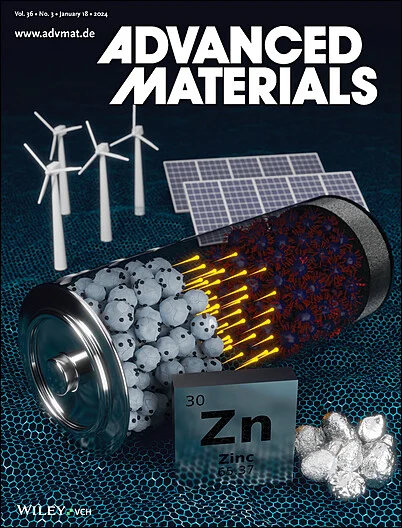IF 27.4
1区 材料科学
Q1 CHEMISTRY, MULTIDISCIPLINARY
引用次数: 0
摘要
界面工程是通过控制表面电子缺陷和载流子捕获来提高过氧化物太阳能电池(PeSCs)效率的一种行之有效的策略。在实验中可以获得包晶和上层电荷萃取层之间 "顶部 "界面的捕获态,并对其进行了广泛的研究。然而,由于缺乏选择性和非破坏性的工具来进入埋藏的界面,人们对包晶石层未暴露的 "底部 "表面的了解仍然很模糊。本文介绍了一种新的光谱学技术,通过将红外光的光学陷阱激活与表面光电压检测相结合,监测埋藏界面上被困载流子的纳秒至毫秒级动态。将该方法应用于各种 PeSC 结构时发现,大多数界面陷阱位于包晶和空穴传输层之间,这表明在所研究的 PeSC 系统中,空穴陷阱(如阳离子和铅空位)比电子陷阱(如卤化物空位)更占优势。所提出的新方法将界面载流子损耗贡献从顶面和埋面分离开来,为通过界面优化实现高性能的沛晶提供了设计思路。本文章由计算机程序翻译,如有差异,请以英文原文为准。

Revealing Trapped Carrier Dynamics at Buried Interfaces in Perovskite Solar Cells via Infrared-Modulated Action Spectroscopy with Surface Photovoltage Detection
Interfacial engineering is a proven strategy to enhance the efficiency of perovskite solar cells (PeSCs) by controlling surface electronic defects and carrier trapping. The trap states at the “top” interface between the perovskite and upper charge extraction layers are experimentally accessible and have been extensively studied. However, the understanding of the unexposed “bottom” surface of the perovskite layer remains elusive, due to the lack of selective and non-destructive tools to access buried interface. Here, a new spectroscopy technique is introduced that monitors nanosecond to millisecond dynamics of trapped carriers at the buried interfaces by combining optical trap activation by infrared light with surface photovoltage detection. Applied to various PeSC architectures, this method reveals that most interfacial traps reside between the perovskite and hole transport layer, suggesting a predominance of hole traps (e.g., cation and lead vacancies) over electron traps (e.g., halide vacancies) in the studied PeSC systems. The proposed new approach separates interfacial carrier-loss contributions from the top and buried surfaces, providing design insights for achieving high-performance PeSCs through interface optimization.
求助全文
通过发布文献求助,成功后即可免费获取论文全文。
去求助
来源期刊

Advanced Materials
工程技术-材料科学:综合
CiteScore
43.00
自引率
4.10%
发文量
2182
审稿时长
2 months
期刊介绍:
Advanced Materials, one of the world's most prestigious journals and the foundation of the Advanced portfolio, is the home of choice for best-in-class materials science for more than 30 years. Following this fast-growing and interdisciplinary field, we are considering and publishing the most important discoveries on any and all materials from materials scientists, chemists, physicists, engineers as well as health and life scientists and bringing you the latest results and trends in modern materials-related research every week.
 求助内容:
求助内容: 应助结果提醒方式:
应助结果提醒方式:


